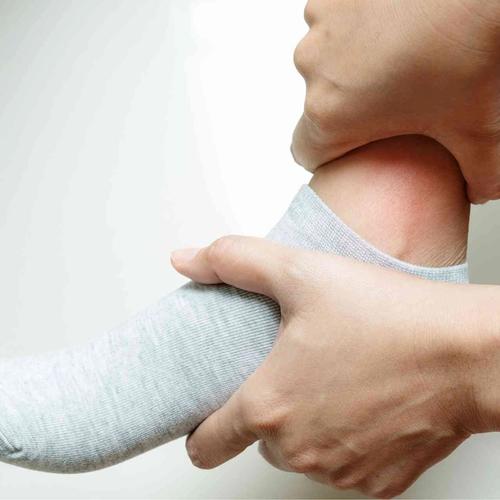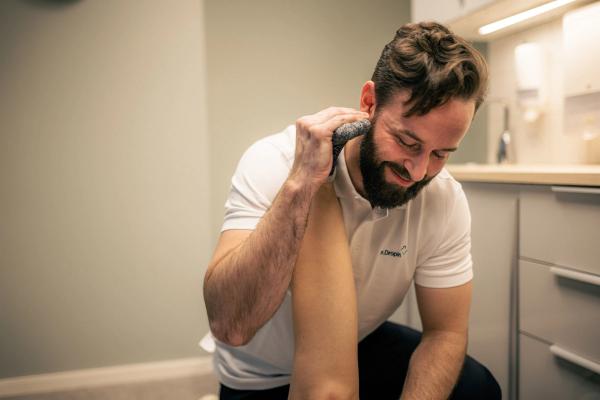Ankle sprain
Ankle sprains are a very common injury. It most often occurs in active teens and young adults. In activities and sports that involve landing after jumping or running in rough terrain, the athlete is particularly vulnerable.
At Dr.Dropin we have skilled therapists that can examine your sprained ancle, and help you get the right treatment.
See availability
Symptoms
If you have sprained your ankle, you may experience one or more of the following symptoms:
- Pain: The most prominent symptom of a sprained ankle is pain, often felt immediately after the injury. The pain can be sharp and concentrated around the affected area, especially when trying to bear weight or move the ankle.
- Swelling and Redness: The ankle may become swollen and red soon after the sprain. The swelling is due to an inflammatory reaction that the body initiates in response to the injury.
- Reduced Mobility: A sprain can limit the mobility of the ankle joint. Victims may find it difficult to bend, twist, or fully bear weight on the ankle.
- Tenderness and Bruising: The area around the injured joint can feel tender to the touch. It's also common to experience bruising due to small bleedings under the skin.

Custom fitted insoles
If you have plantar fasciitis, you may experience one or more of the following symptoms:
- Pain under the heel or foot.
- Pain with weight bearing - standing, walking, running
- Increased pain on loading after sitting or lying down for a while
- Can involve one or both feet.
Plantar fasciitis is a condition that can develop gradually, and the symptoms can vary in intensity. It is important to seek professional guidance for an accurate diagnosis and treatment if you experience these symptoms.
Treatment and prognosis
The treatment of plantar fasciitis often involves various approaches to achieve specific treatment goals. Here are some common treatment methods.
- Pain relief: Through manual techniques such as joint adjustments, massage, and trigger point therapy, the pain in heel pain can be reduced.
- Increased flexibility: Specific stretching exercises and techniques can help improve the flexibility of the calf and foot.
- Strength training: Gradual introduction of strength exercises for the muscles in the calf and foot can help reduce strain on the tendon.
- Biomechanical evaluation: Analysis of running technique and potential adjustment of footwear or orthotics to reduce stress on the plantar fascia.
- Functional rehabilitation: Gradually resume running and other daily activities, with an emphasis on restoring optimal function in the foot.
It's important to understand that the treatment for plantar fasciitis should be tailored to individual needs and may vary from person to person. A thorough evaluation and close collaboration with an experienced physiotherapist or chiropractor are crucial for developing an effective treatment plan.
PEACE
During the first few days, your injury needs "PEACE".
P for Protect
- Protect the injury site. Avoid activity and movements that cause increased pain.
E for Elevate
- Students (raise) your foot above heart level as often as possible.
A for Avoid anti-inflammatory modalities
- Avoid anti-inflammatory medications and ice as it seems to reduce tissue healing in the long run.
C for Compression
- Compression with bandage or tape.
E for Education
- Your body knows best, and you should be instructed by healthcare professionals to let your body deal with the damage naturally.
LOVE
After the first days are over, your injury needs "LOVE"
L for Load
- Early strain on the ankle leads to better outcomes. Let pain and swelling determine when the body is ready for gradual exertion and return to normal activity.
O for Optimism
- Stay optimistic and positive during your workout. The brain plays an important role in rehabilitation.
V for Vascularization
- Physical activity that leads to increased blood circulation to the injured area is important for repairing damaged tissue.
E for Exercise
- Training for increased mobility, strength and balance are best measures for treating ankle sprains and to reduce the risk of repeated sprains.

Do you want guidance to find out which treatment suits you best?

Telephone
Authorized healthcare personnel assist you over the phone. We answer the phone within 60 seconds. Free of charge.

Find therapist
Find a therapist that suits you and your needs by filtering on one or more criteria.
Use your health insurance
We cooperate with all the major insurance companies, so that you can use your health insurance with us if you have foot pain or other problems.
Read more about how to use your health insurance here